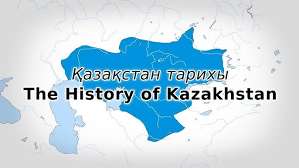 |
Discover Kazakhstan's Ancient Civilizations, Wars, Independence, and Key Historical Leaders Shaping the Nation's Future |
Kazakhstan's history is rich with stories of nomadic empires, foreign domination, and a journey toward independence. From ancient civilizations to the modern-day nation-state, Kazakhstan has undergone significant transformations, shaping the country as we know it today. The region has witnessed the rise and fall of empires, including the Mongol Empire, as well as struggles for sovereignty against powerful neighbors like Russia.
Ancient Kazakhstan Civilizations and Nomadic Empires:
Kazakhstan's early history traces back to the nomadic tribes of the Eurasian Steppe, where the Saka (a Scythian-related tribe) and Xiongnu established a strong presence. These tribes led a life of migration, warfare, and trade, laying the groundwork for the future of Kazakhstan. During the 13th century, Genghis Khan's Mongol Empire expanded across Central Asia, incorporating Kazakhstan into its vast territory. The region later became part of the Golden Horde, a Mongol successor state.
Formation of the Kazakh Khanate:
In the 15th century, the Kazakh Khanate was established after breaking away from the Uzbek Khanate. This marked a pivotal moment in Kazakhstan's history, with the formation of a distinct Kazakh identity and ethnicity. The Khanate would play a central role in unifying various tribal groups and defending Kazakhstan's territory against external invaders.
Russian Expansion and Soviet Era:
In the 18th century, the Russian Empire began expanding into Kazakhstan. By the 19th century, much of the territory had been annexed, making it part of the Russian Empire. Following the Russian Revolution, Kazakhstan became a part of the Soviet Union. Initially, it was an autonomous republic within the Soviet Union but was granted full status as the Kazakh Soviet Socialist Republic in 1936.
During this period, Kazakhstan experienced forced collectivization under Soviet rule, which led to famine and the death of over 1.5 million Kazakhs. Additionally, significant demographic changes took place, with the influx of Russians and other Slavs altering the country's ethnic composition.
The Road to Independence:
Kazakhstan declared its independence from the Soviet Union on December 16, 1991, following the dissolution of the USSR. It became the last Soviet republic to achieve independence, marking a new chapter in the nation's history. Since then, Kazakhstan has navigated political and economic changes, establishing itself as a sovereign nation and a key player in Central Asia.
Important Events in Kazakhstan's History:
-
Independence from the Soviet Union (1991): The most significant event in modern Kazakhstan's history was its declaration of independence in 1991, signaling a break from Soviet control.
-
Economic Reforms: Following independence, Kazakhstan embarked on a path of economic reforms, focusing on modernizing infrastructure and encouraging foreign investment.
-
Political Stability: Kazakhstan has worked to maintain political stability while balancing its relationships with Russia, China, and other Central Asian nations.
Famous Leaders of Kazakhstan in History:
Kazakhstan's history is also marked by notable leaders, including:
-
Abul Khair Khan: A significant figure in the formation of the Kazakh Khanate.
-
Almaty and Nur-Sultan (formerly Astana): Leaders such as Nursultan Nazarbayev, Kazakhstan's first president, helped guide the country through its post-independence era.
The Influence of Wars and the Soviet Era:
Kazakhstan's historical timeline is also shaped by the world wars and its role within the Soviet Union. During the World Wars, Kazakhstan contributed troops and resources, despite suffering from the oppressive policies of the Soviet government.
Scientific Discoveries and Cultural Contributions:
Kazakhstan has a rich cultural heritage, with contributions in areas like astronomy and philosophy. The discovery of important mineral resources, along with scientific advances in agriculture, continue to shape the nation's growth. Kazakhstan is also famous for its traditional music, art, and cuisine, all of which play a vital role in its identity.
Can You Still Travel to Kazakhstan?
Yes, Kazakhstan is an increasingly popular tourist destination. The country boasts breathtaking landscapes, including the Altai Mountains, Charyn Canyon, and the vast steppes. It is an emerging hub for international business and tourism, with attractions ranging from historical sites like the Mausoleum of Khoja Ahmed Yasawi to modern cities like Almaty and Nur-Sultan.
What Are 5 Facts About Kazakhstan?
-
Kazakhstan is the largest landlocked country in the world.
-
It has one of the world’s largest reserves of uranium.
-
The country has 14 different ethnic groups, with Kazakhs making up the majority.
-
Kazakhstan is home to the Baikonur Cosmodrome, the world's first space launch facility.
-
It is the 9th largest country in the world by land area.
Popular Drink in Kazakhstan:
The most popular drink in Kazakhstan is kymyz, a fermented mare's milk that has been a staple of Kazakh nomadic culture for centuries.
Climate in Kazakhstan:
Kazakhstan experiences a continental climate, with cold winters and hot summers. The northern regions can be very cold in winter, while the southern areas have a more temperate climate.
What Was Kazakhstan's Old Name?
Before gaining independence in 1991, Kazakhstan was known as the Kazakh Soviet Socialist Republic (Kazakh SSR), part of the Soviet Union. Historically, it was also referred to as part of the greater Turkic and Mongolic empires and khanates, where the term "Kazakh" emerged in the 15th century.
What Was the History of Kazakhstan Before Islam?
Before the advent of Islam, Kazakhstan was influenced by various religious traditions, including animism, Shamanism, and Tengriism, which is a form of sky worship. Islam became widespread after the 10th century, primarily brought by traders and missionaries along the Silk Road.
Conclusion:
Kazakhstan's history is a testament to the resilience of its people, who endured centuries of invasions, foreign rule, and internal strife. From the early nomadic empires to its emergence as an independent nation, Kazakhstan has undergone significant transformations, shaping its current position as a prosperous and growing country in Central Asia.




